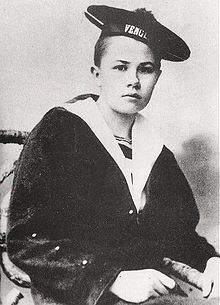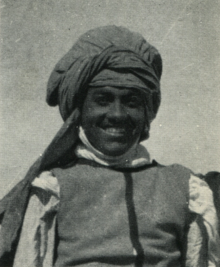“Now more than ever do I realize that I will never be content with a sedentary life, that I will always be haunted by thoughts of a sun-drenched elsewhere.”
(Isabelle Eberhardt)
It’s February.
It may be the shortest month of the year, but, for many, it seems like the longest. As I write this, I am looking out a bleak, gray, drizzling sky that honestly hasn’t seemed to have changed in about fourteen years. And if the conversations I’ve had with any number of you charming, winter-weary people, is that we could all use a long vacation, to a place full of sunshine, and adventure…and maybe a miniature golf course or two…
So, in honor of our collective wanderlust, we at the Free For All are celebrating the birthday of Isabelle Eberhardt, a Swiss explorer and writer, born on this day in 1877.
 Eberhardt’s parents, Alexandre and Nathalie, both abandoned previous marriages and families to be together–they met because Alexandre was hired to tutor Nathalie’s children–and set up a life in Geneva, where Isabelle grew up. In such a non-conformist family, it was no surprised that young Isabelle grew up exceptionally well-educated, and when she expressed a desire to dress in boy’s, and later, men’s clothing, because they allowed a greater physical and social freedom. She began writing and publishing fascinating, avant-garde fiction under the name of Nicolas Podolinsky when she was eighteen, and, when her father was sent to North Africa with the French Foreign Legion, she begged him to keep a detailed diary of everything he saw there, so that she could write about his adventures, as well.
Eberhardt’s parents, Alexandre and Nathalie, both abandoned previous marriages and families to be together–they met because Alexandre was hired to tutor Nathalie’s children–and set up a life in Geneva, where Isabelle grew up. In such a non-conformist family, it was no surprised that young Isabelle grew up exceptionally well-educated, and when she expressed a desire to dress in boy’s, and later, men’s clothing, because they allowed a greater physical and social freedom. She began writing and publishing fascinating, avant-garde fiction under the name of Nicolas Podolinsky when she was eighteen, and, when her father was sent to North Africa with the French Foreign Legion, she begged him to keep a detailed diary of everything he saw there, so that she could write about his adventures, as well.
Isabelle and her mother visited North Africa two years later, and, much to the approbation of their fellow French colonists, refused to live within the French settlement, instead renting a house from an Arab family. Isabelle also adopted native male dress because women were unable to travel unveiled and unchaperoned under Islamic tradition.

Both of Isabelle’s parents died within the next two years, and, having declared herself free of any human attachment, Isabelle decided to live the life of a vagrant, and, after a brief stay in Paris, moved to Algeria (then a French colony). There, she fell in love with a soldier named Slimane Ehnni, with whom she would live for the rest of her life. Her less than conventional choices completely ostracized her from the French colonists in Algeria (and she blamed a near-fatal attack on a French attempt to assassinate her) but Isabelle was openly welcomed by the Algerian natives, was accepted into the Sufi order known as the Qadiriyya without question, where she found protection, and was given and Arabic name, as well.
Isabelle Eberhardt was killed in 1904 when a flash flood swept away the mud hut in which she was living. Her husband, Slimane Ehnni, survived, and buried her in Aïn Sefra, Algeria, and ensured that her tombstone carried both her French and Arabic names.
A number of manuscripts were found following Isabelle’s death, and, with help from a French journalist in the area, they began to be published around 1906. She was decidedly anti-imperialist, arguing for the freedom of native peoples, and several historians credit her as the first voice of decolonization in French Algeria. The Library has a number of her works in translation, so you can get to know Isabelle, too.

So, in honor of the remarkable Isabelle Eberhardt, let’s embrace our wanderlust today, and start reading of all the places we can’t manage to get to see firsthand. Perhaps it won’t make the sun shine any brighter, but it might make the days brighter, for all that.
To get to know Isabelle Eberhardt better, check out:
 Writings from the Sand: Collected Works of Isabelle Eberhardt & The Oblivion Seekers and Other Writings, both of which are Isabelle’s own words, describing French Algeria, her wanderings around North Africa, and her own observations of life there. The editor’s introduction and notes throughout put these essays into context, and provide marvelous insight into the world that Isabelle inhabited, offering you the chance to take a visit through both time and space along with her.
Writings from the Sand: Collected Works of Isabelle Eberhardt & The Oblivion Seekers and Other Writings, both of which are Isabelle’s own words, describing French Algeria, her wanderings around North Africa, and her own observations of life there. The editor’s introduction and notes throughout put these essays into context, and provide marvelous insight into the world that Isabelle inhabited, offering you the chance to take a visit through both time and space along with her.
Annette Kobak has also written a biography of Isabelle, for those who wish to get to know her a bit better, and for those who prefer fiction, try William Bayer’s Visions of Isabelle for a fictional account of this remarkable woman.

